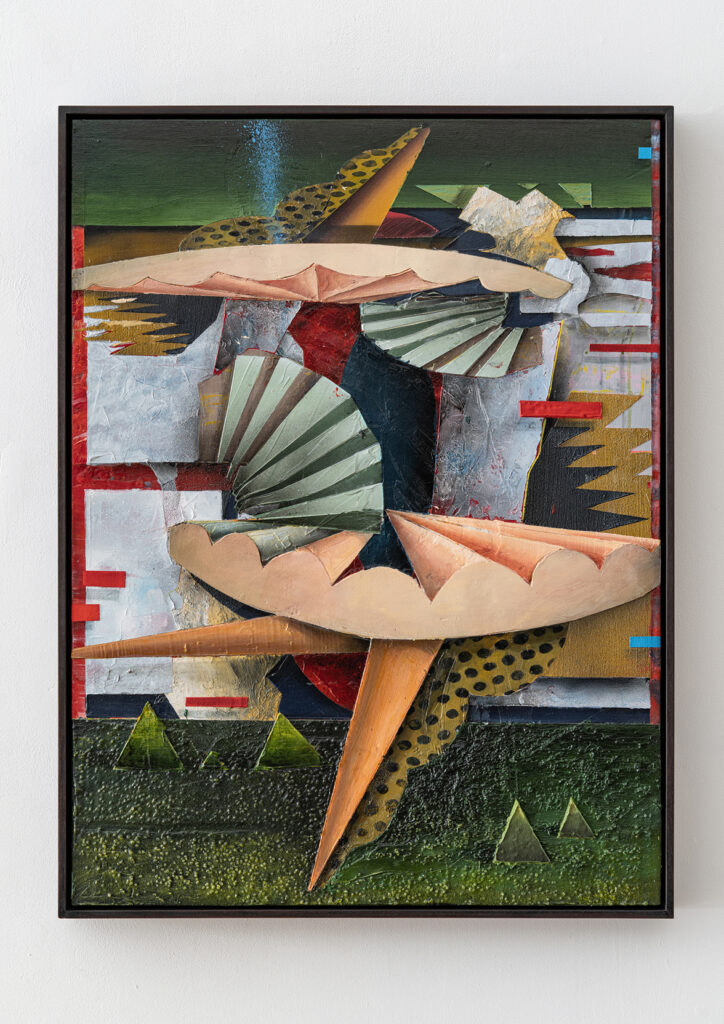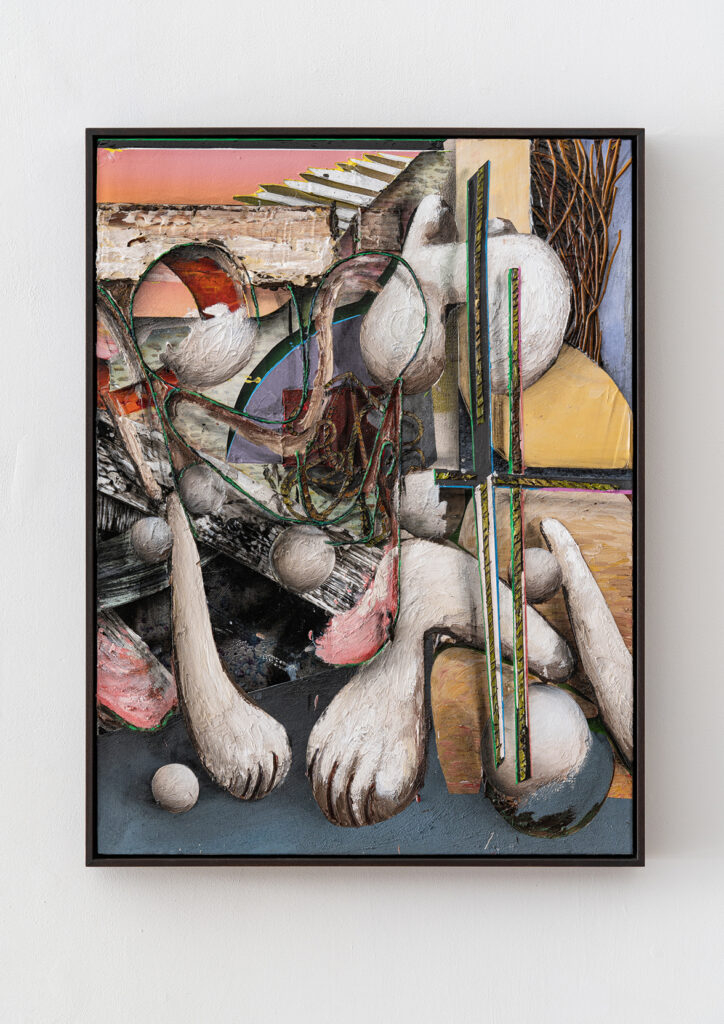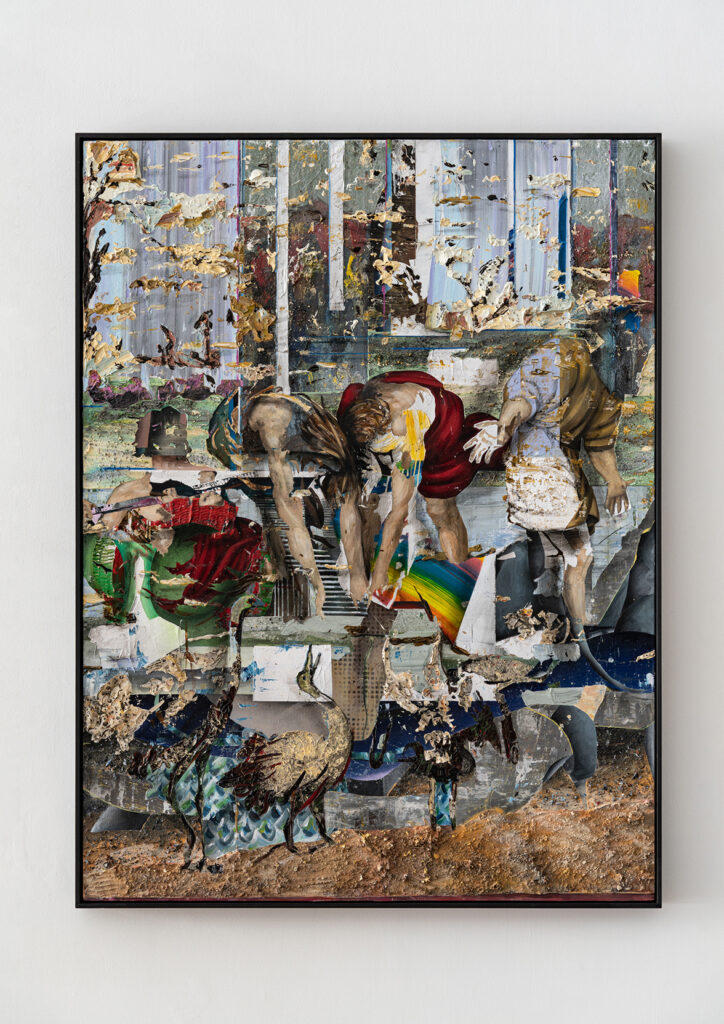by Mary Hrbacek

Grimm presents “Tetris,” an exhibition of seventeen new acrylic and acrylic emulsion paintings by Dutch artist Tjebbe Beekman. In Beekman’s deeply felt and strongly envisioned images, the components and fragments function as indefinable players in what can be described as confounding theatrical productions; they immediately impress the viewer with their powerful symbolic meaning. The title of the exhibition lends insights into Beekman’s artistic intentions. “Tetris” is defined as an “endeavor involving rearranging things of a different shape into physical space.”
Beekman excels at making visually convincing painted “collage” details. The interconnecting dystopian elements read as layers of expressive recognizable objects such as cloth, balls, rope, pieces of wood, trays and sticks to name but a few, whose relationships to each other seem unfathomable. They convey deeply intriguing yet puzzling undefined messages. The variety of textures, colors, unspecified articles and entities grip the viewer in a psychic drama presented in many of the works, in the pictorial space of a Picasso collage or Synthetic Cubist still life. The shallow arena appears to be constructed of overlapping items that might have been dredged from a cellar, woodshed or attic trunk.

The works on view with their attendant narrative titles, give the impression that they relate personally to the artist’s psychic and emotional states of consciousness. These pieces have underpinnings in Old Master compositions; Poussin comes to mind. They have no pop culture references beyond the 1980’s arcade video game entitled “Tetris.” Playing this game is said to thicken the cortex and possibly increase brain competence. The painting actually entitled “Tetris” integrates unrelated strata of abstract and figurative items, which may symbolize the chaos in which we live in the world. Arranging ultra-complex configurations woven within pictorial structures probably provides relief for distressing emotional experiences. Art-making can be a constructive venue for exploring feelings and venting emotions directed at the charged episodes that cling inexorably in our consciousness.

The piece entitled “The Miraculous Drought” diverges from the collage-based still life works, with a storm setting in which four human figures reach dramatically into a trough to collect water, amongst a barrage of flying debris. A desperate peacock, the flamboyant bird that symbolizes personal vanity, cranes its neck to beg for water, verifying that human and animal needs intersect. In a mesmerizing display of nature’s chaotic powers, the debris blows wildly across the top of the format signaling an apocalyptic natural disaster which pits us not only against nature, but against each other. It seems the artist is striving to reconcile life’s struggles with its rewards.
The various collage-like and cubistic spaces seem to express their own particular emotional conundrums disguised within the undefined forms presented. “To Pray for the Living and the Dead” hints at aquatic looking shapes that seem to intersect a black empty area that conceivably signifies the “self.” Sensory stimulation gives a certain distraction and pleasure to life, when conflicts and unresolved relationships, especially from the past, become intolerable to bear.
The artist’s superb technical mastery of the medium comprises a striking underlying message that permeates this mesmerizing body of works. With images whose underpinnings in the old and new masters are articulated by honed elements with deeply saturated hues, few art shows today are more serious or more engulfing.
Tjebbe Beekman: Tetris (October 21 through November 12, 2022) at Grimm Gallery, 54 White Street, New York City, NY 10013
